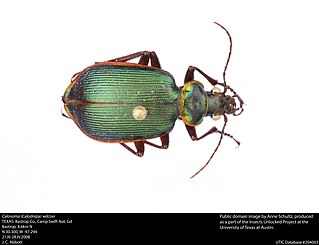
Ground beetles are a large, cosmopolitan family of beetles, the Carabidae, with more than 40,000 species worldwide, around 2,000 of which are found in North America and 2,700 in Europe. As of 2015, it is one of the 10 most species-rich animal families. They belong to the Adephaga. Members of the family are primarily carnivorous, but some members are herbivorous or omnivorous.

Joseph Le Conte was a physician, geologist, professor at the University of California, Berkeley, early California conservationist, and eugenicist.

Hygrotus is a genus of beetle in family Dytiscidae. It contains two subgenera and about 70 species, including:

Altica is a large genus of flea beetles in the subfamily Galerucinae, with about 300 species, distributed nearly worldwide. The genus is best represented in the Neotropical realm, well represented in the Nearctic and Palearctic, but occurs also in the Afrotropic, Indomalaya, and Australasia. The species are similar to each other, small metallic blue-green-bronze beetles, often distinguished from each other only by the aedeagus. The species of Altica, both as larvae and as adults, are phytophagous, feeding on plant foliage of various food plant taxa, specific for each Altica species. Onagraceae and Rosaceae are the dominant host plant families for Holarctic species. The adult Altica beetles are able to jump away when approached.

Dicerca is a genus of beetles in the family Buprestidae. It contains the following species:
Calosoma bridgesi is a brachypterous species of ground beetle in the subfamily of Carabinae. The species is 18–20 millimetres (0.71–0.79 in), is reddish-black coloured, and is endemic to the Andes mountains of Bolivia, Argentina, and Chile where it is found on elevation of 3,500 metres (11,500 ft). It flies in January and February.
Calosoma lepidum is a species of ground beetle in the subfamily Carabinae. It was described by John Lawrence LeConte in 1844.

Calosoma macrum is a species of ground beetle in the subfamily Carabinae. It was described by John Lawrence LeConte in 1853. The species is 24–30 millimetres (0.94–1.18 in) long, black, and lives at an elevation of 1,000 to 1,600 metres.
Calosoma moniliatum is a species in the beetle family Carabidae. It is found in the United States and Canada.
Calosoma prominens is a species of ground beetle in the subfamily Carabinae. It was described by John Lawrence LeConte in 1853.
Calosoma macrum is a species of ground beetle in the subfamily Carabinae. It was described by John Lawrence LeConte in 1852. The species is 22–29 millimetres (0.87–1.14 in) long, black, and lives at an elevation of 1,100 to 1,700 metres in Guerrero, Mexico. It flies in June and October.
Calosoma semilaeve, the black calosoma, is a species of ground beetle in the subfamily Carabinae. It was described by John Lawrence LeConte in 1851.
Calosoma simplex is a species of ground beetle in the subfamily Carabinae. It was described by John Lawrence LeConte in 1878.
Calosoma tepidum is a species of ground beetle in the subfamily Carabinae. It was described by John Lawrence LeConte in 1851.

Calosoma wilcoxi is a species of ground beetle in the subfamily Carabinae. It was described by John Lawrence LeConte in 1848.
Calosoma wilkesii is a species in the beetle family Carabidae. It is found in the United States and Canada.

Magdalis is a genus of wedge-shaped bark weevils in the family Curculionidae. There are at least 20 described species in Magdalis.

Selatosomus is a genus of beetles belonging to the family Elateridae. The species of this genus are found in Europe, Japan, southern Africa and North America, and most of the species were formerly included in the genus Ctenicera.








